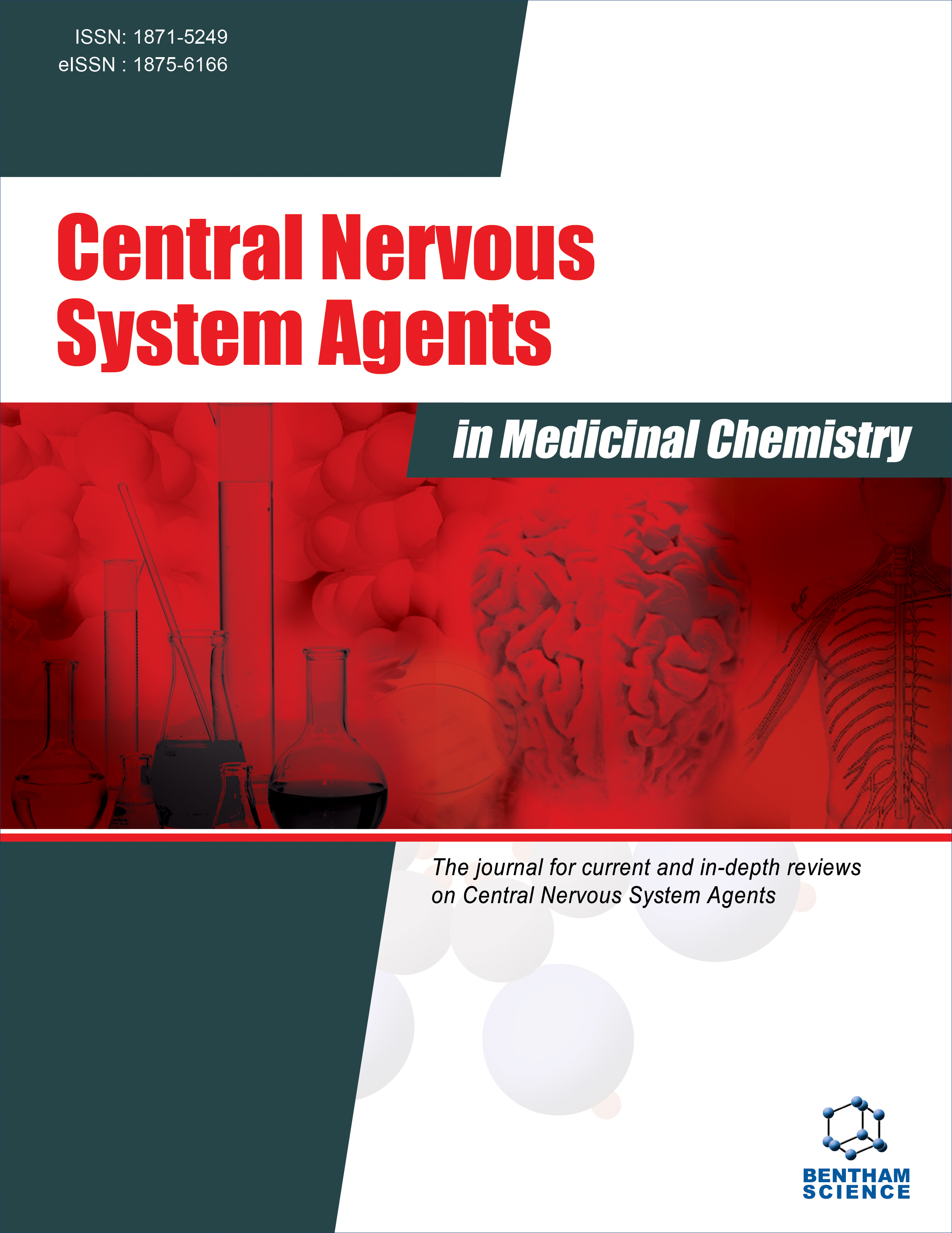- Home
- A-Z Publications
- Central Nervous System Agents in Medicinal Chemistry (Formerly Current Medicinal Chemistry - Central Nervous System Agents)
- Previous Issues
- Volume 23, Issue 3, 2023
Central Nervous System Agents in Medicinal Chemistry (Formerly Current Medicinal Chemistry - Central Nervous System Agents) - Volume 23, Issue 3, 2023
Volume 23, Issue 3, 2023
-
-
Advancement in Epilepsy Pharmacotherapy: An Insight into the Pharmacophoric Approaches of Recent Drugs
More LessEpilepsy is the most general, extensive, and severe neurological disorder, affecting more than 50 million individuals globally. Initially, conventional medicines and simple salts like potassium bromide were employed as antiepileptic medication candidates. Nowadays, large number of anticonvulsant drugs have been discovered as first-generati, second-generation and newer drugs which are still in development phases. Read More
-
-
-
Tianeptine Affects the Improvement of Behavioral Defects, such as Schizophrenia, Caused by Maternal Immune Activation in the Mice Offspring
More LessAuthors: Kooseung Jung and Jun-Tack KwonBackground: Simultaneously with studies on animal models of fetal-induced maternal immune activation, related studies documented behavior, neurophysiological, and/or neurochemical disorders observed in some neuropsychiatric disorders, including autism and schizophrenia. Objective: To investigate whether treatment tianeptine might ameliorate maternal immune activation (MIA)-induced behavioral deficits in the offsprin Read More
-
-
-
Intracerebroventricular Injection of MHY1485 Blocked the Beneficial Effect of Adiponectin on Aversive Memory in the STZ Model of Dementia
More LessAuthors: Samira Rashtiani, Iran Goudarzi, Adele Jafari and Kambiz RohampourBackground: The most prominent adipokine, adiponectin (APN), has an adverse relationship with the malfunction of adipose tissue. Obesity causes a decrease in plasma APN levels, which eventually results in insulin resistance and diabetes. In this study, we assessed how the effects of APN on memory are influenced by the insulin receptor substrate-1 (IRS-1) and the mammalian target of rapamycin (mTOR) pathways. Methods: Read More
-
-
-
Design, Synthesis, and Pharmacological Evaluation of Novel Tacrine Derivatives as Multi-target ANTI-Alzheimer’s Agents In Rat Models
More LessAuthors: Remya R.S., Ramalakshmi N., Muralidharan P. and Nalini C.N.Background: Alzheimer’s disease is a progressive neurodegenerative disorder for which no curative drugs are available and treatment available is just palliative. Objectives: Current research focused on design of Tacrine-Flavone hybrids as multitargeted cholinesterase and monoamine oxidase B inhibitors. Methods: A total of 10 Tacrine- Flavone hybrids were designed, synthesized and characterized. The in vitro neurotoxicity and h Read More
-
-
-
The Effect of Olibanum on the Rats with Memory Deficit Induced by Scopolamine
More LessAuthors: Sara Kazemi, Narges Marefati, Farimah Beheshti, Hossein Salmani, Maryam Bigham and Mahmoud HosseiniBackground: Oxidative stress is an important contributor to Alzheimer's disease. Olibanum has therapeutic effects on various diseases. The effect of Olibanum on memory deficit induced by scopolamine (Sco) was challenged. Methods: Four groups were considered as (1) control (2) Sco, (3-4) Sco - Olib 100 and 200 mg/kg. Treatment by Olib or vehicle was done for two weeks. The third week was accompanied by the Morris wat Read More
-
-
-
Comparison of Psychological Disorders During and After Pregnancies Caused by Assisted Reproductive Treatments and Spontaneous Pregnancies
More LessAuthors: Mahvash Zargar, Mehdi Sayyah, Roshan Nikbakht and Zahra AbdipourIntroduction: Mental disorders during pregnancy are one of the major public health problems because of its effect on both mother and child, but the prevalence of psychiatric disorders in infertile women is largely unknown to compare psychiatric disorders during and after pregnancies with assisted reproductive therapies (ART) and spontaneous pregnancies. Methods: This cross-sectional study was conducted on pregnant wo Read More
-
-
-
The Cracked Potential of Boron-containing Compounds in Alzheimer’s Disease
More LessAuthors: Marvin A. Soriano-Ursúa and Eunice Dalet Farfán-GarcíaAlzheimer’s disease (AD) is a relevant neurodegenerative disease worldwide. Its relevancy is mainly due to its high prevalence and high global burden. Metalloids have attracted attention as their serum levels seem to differ between affected patients and healthy individuals. On the other hand, atoms of some metalloids have been included in bioactive molecules, exerting some interesting effects, mainly due to their ameli Read More
-
Volumes & issues
-
Volume 25 (2025)
-
Volume 24 (2024)
-
Volume 23 (2023)
-
Volume 22 (2022)
-
Volume 21 (2021)
-
Volume 20 (2020)
-
Volume 19 (2019)
-
Volume 18 (2018)
-
Volume 17 (2017)
-
Volume 16 (2016)
-
Volume 15 (2015)
-
Volume 14 (2014)
-
Volume 13 (2013)
-
Volume 12 (2012)
-
Volume 11 (2011)
-
Volume 10 (2010)
-
Volume 9 (2009)
-
Volume 8 (2008)
-
Volume 7 (2007)
-
Volume 6 (2006)
Most Read This Month
Article
content/journals/cnsamc
Journal
10
5
false
en


